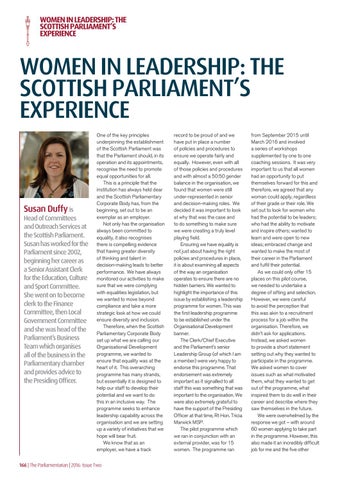WOMEN IN LEADERSHIP: THE SCOTTISH PARLIAMENT’S EXPERIENCE
WOMEN IN LEADERSHIP: THE SCOTTISH PARLIAMENT’S EXPERIENCE
Susan Duffy is
Head of Committees and Outreach Services at the Scottish Parliament. Susan has worked for the Parliament since 2002, beginning her career as a Senior Assistant Clerk for the Education, Culture and Sport Committee. She went on to become clerk to the Finance Committee, then Local Government Committee and she was head of the Parliament’s Business Team which organises all of the business in the Parliamentary chamber and provides advice to the Presiding Officer.
One of the key principles underpinning the establishment of the Scottish Parliament was that the Parliament should, in its operation and its appointments, recognise the need to promote equal opportunities for all. This is a principle that the institution has always held dear and the Scottish Parliamentary Corporate Body has, from the beginning, set out to be an exemplar as an employer. Not only has the organisation always been committed to equality, it also recognises there is compelling evidence that having greater diversity of thinking and talent in decision-making leads to better performance. We have always monitored our activities to make sure that we were complying with equalities legislation, but we wanted to move beyond compliance and take a more strategic look at how we could ensure diversity and inclusion. Therefore, when the Scottish Parliamentary Corporate Body set up what we are calling our Organisational Development programme, we wanted to ensure that equality was at the heart of it. This overarching programme has many strands, but essentially it is designed to help our staff to develop their potential and we want to do this in an inclusive way. The programme seeks to enhance leadership capability across the organisation and we are setting up a variety of initiatives that we hope will bear fruit. We know that as an employer, we have a track
166 | The Parliamentarian | 2016: Issue Two
record to be proud of and we have put in place a number of policies and procedures to ensure we operate fairly and equally. However, even with all of those policies and procedures and with almost a 50:50 gender balance in the organisation, we found that women were still under-represented in senior and decision-making roles. We decided it was important to look at why that was the case and to do something to make sure we were creating a truly level playing field. Ensuring we have equality is not just about having the right policies and procedures in place, it is about examining all aspects of the way an organisation operates to ensure there are no hidden barriers. We wanted to highlight the importance of this issue by establishing a leadership programme for women. This was the first leadership programme to be established under the Organisational Development banner. The Clerk/Chief Executive and the Parliament’s senior Leadership Group (of which I am a member) were very happy to endorse this programme. That endorsement was extremely important as it signalled to all staff this was something that was important to the organisation. We were also extremely grateful to have the support of the Presiding Officer at that time, Rt Hon. Tricia Marwick MSP. The pilot programme which we ran in conjunction with an external provider, was for 15 women. The programme ran
from September 2015 until March 2016 and involved a series of workshops supplemented by one to one coaching sessions. It was very important to us that all women had an opportunity to put themselves forward for this and therefore, we agreed that any woman could apply, regardless of their grade or their role. We set out to look for women who had the potential to be leaders; who had the ability to motivate and inspire others; wanted to learn and were open to new ideas; embraced change and wanted to make the most of their career in the Parliament and fulfil their potential. As we could only offer 15 places on this pilot course, we needed to undertake a degree of sifting and selection. However, we were careful to avoid the perception that this was akin to a recruitment process for a job within the organisation. Therefore, we didn’t ask for applications. Instead, we asked women to provide a short statement setting out why they wanted to participate in the programme. We asked women to cover issues such as what motivated them, what they wanted to get out of the programme, what inspired them to do well in their career and describe where they saw themselves in the future. We were overwhelmed by the response we got – with around 60 women applying to take part in the programme. However, this also made it an incredibly difficult job for me and the five other
